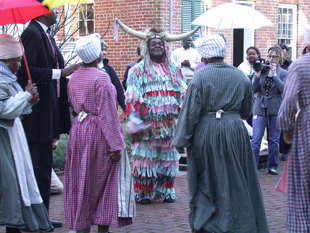
Good Morning POU!
We continue our look at traditions and customs for American slaves during the last week of the year.

In antebellum North Carolina, Christmas season was the time for an African American celebration found almost nowhere else in North America, but widespread through the islands of the Caribbean. Variously called Jonkonnu, Johnkannaus, John Coonah, or John Canoe, the custom was described in the slave community of Jamaica in the late eighteenth century where it was thought to have been of African origin.

Although the details often changed from place to place, Jonkonnu usually involved several African American men who dressed in costumes made of rags and animal skins with grotesque masks and horns. Sometimes one of their number wore his best clothes instead. They danced wildly, often playing musical instruments and singing. In towns, the Jonkonnu men went from house to house while on plantations they performed at the homes of masters, overseers, and other white people. They expected to be rewarded with gifts of money or liquor. Jonkonnu dancers were often accompanied by crowds of men and women who cheered them on while taking no direct part in the performance.
Slave Harriet Brent Jacobs described the custom:
“Every child rises on Christmas morning to see the John Kannaus. Without them Christmas would be shorn of its greatest attraction… a box covered with sheepskin is called the gumbo box. A dozen beat on this while others strike triangles and jawbones to which a band of dancers keep time. For a month previous they are composing songs.”
Jonkonnu obviously represented a time of release and enjoyment for slaves from the drudgery of their day–to–day work. Some historians believe that it may also have been a time when the constraints of the slave system were loosened in other ways. On plantations in North Carolina slaves of all sorts had access to their masters in ways that they seldom had during the year. The Jonkonnu performers and their accompanying crowd usually came right up to their master’s house, a privilege usually denied to all but house servants.
In Wilmington, the “John Kuners” would dance throughout the town to the rhythmic chants of:
“Hah! Low! Here we go! Hah! Low! Here we go!
Hah! Low! Here we go! Kuners come from Denby!”
With the rattles of bones, the blowing of cow’s horns, and the tinkling of tambourines, the singing slaves, grotesque in their “Kuner” costumes, would halt whenever an appreciative crowd gathered. Strips of brightly colored cloth sewn to their clothes fluttered gaily as the John Kuners danced merrily.
They were bedecked in horned masks, beards, staring eyes and enormous noses with grinning mouths. All were men, but some would dress as women.

After a few songs and dancing, the Kuners would approach the spectators with hat extended to collect a monetary reward for the antics. The Kuners would then depart for another crowd to dance and sing for and the usual reward.
After the performance, the master would often speak to the performers and shake hands with them, another departure from usual practice. Jonkonnu continued in North Carolina after emancipation, at least in Wilmington, where it was observed as late as 1880. A version of it also seems to have been adopted by whites in the late nineteenth century. In the end, however, it may have been too closely tied to the slave system in which it arose to have survived long after freedom. The custom fell into disuse in the 1880’s after being tabooed by black residents, it was seen “as tending to lower them as a race in the eyes of the public (Stories Old and New, Louis T. Moore, Broadfoot Publishing, 1956).”
